
This article is about how to have success with Winter Steelhead Fishing. We will cover fishing techniques, how to read water, and how to rig up to catch one of the greatest sport fish in the world.
Winter Steelhead Fishing is one of the most popular fisheries in the Pacific Northwest and in the Great Lakes region.
The season for winter steelhead in the PNW often gets started right around the holidays of Thanksgiving and Christmas and continues well into March and April depending on the river and run of fish.
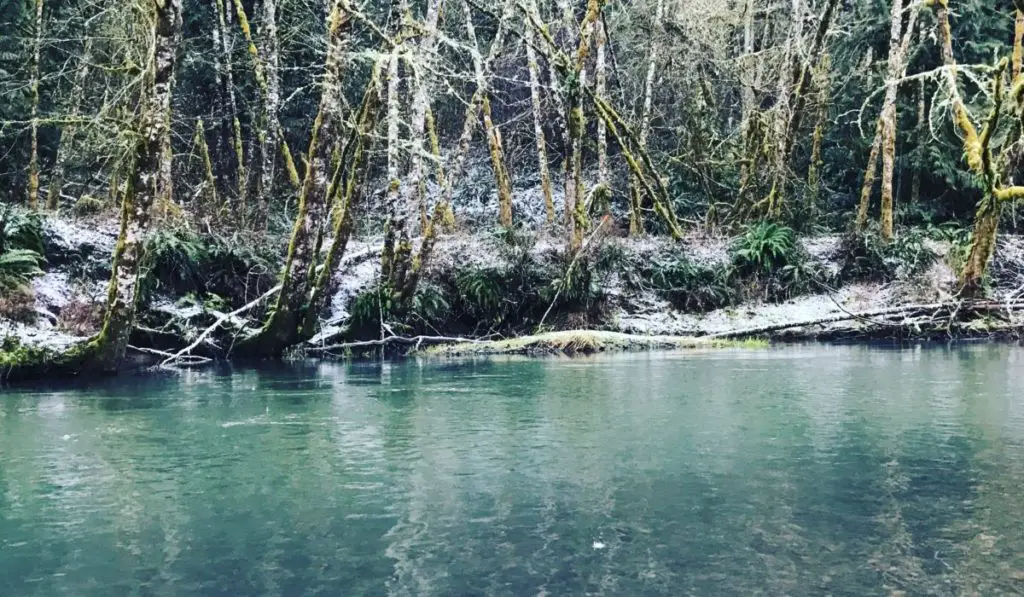
The experience of fishing for winter steelhead is one of the most epic of all angling pursuits.
The weather ranges from the torrential downpour that’s just warm enough to not be snow and finds its way into every part of your layered clothing, to the kind of cold temperatures that numb your hands and make you wonder whether there is something wrong with you for fishing in these conditions (for the record, there is!).
There is also the odd “nice winter day” mixed into the more extreme conditions.
But it’s that setting of beautiful winter scenery, with great challenge and difficulty that the payoff becomes so sweet when the discomfort of the elements melts away as the chrome lightning bolt that is the winter steelhead grabs our offering and starts to pull.
For many, the winter steelhead season is the mountain-top angling experience. For others, they are enchanted by the descriptions of winter steelhead fishing that they read online or hear about from their friends, but are not sure how to get started.
This winter steelhead article attempts to provide the most comprehensive, and easy to understand tutorial for the absolute beginner or current steel-header looking to more deeply understand how to be successful chasing this amazing fish.
Below is a YouTube video I made on how to fish for Winter Steelhead in Western Washington from 2021 with all the no-bait restrictions. Please like and subscribe to my channel on YouTube “PNW Best Life”.
Finding Winter Steelhead / Reading Water
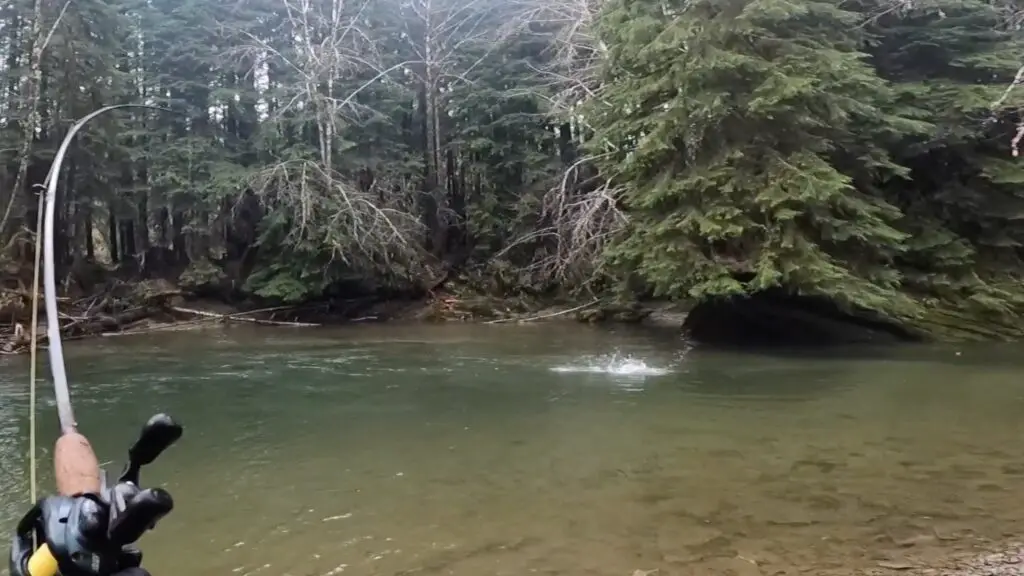
What separates the beginner and intermediate steel-header from the expert? The ability to read water to find winter steelhead.
Anyone can go down to the popular steelhead hole near a hatchery, park where everyone else is parking, fish where everyone else is fishing and pull up a steelhead or two if they are willing to put their time in.
But, I believe many steelheaders are looking for something more.
Looking for that bit of serenity and a portion of the river that nobody is fishing, few know about and you can have to yourself. Sure, anyone can hike down a river away from people armed with fishing rods and gear, but we want to find the steelhead as well.
Take a look at our page titled “Where to find Winter Steelhead” which is completely devoted to the topic in the state of Washington, but also hopefully gives you ideas wherever you are fishing for Winter Steelhead.
Have you found a decent river with winter steelhead in it, but you aren’t sure you’re fishing in the right spot to put your offering in front of fish? Head over to our page dedicated to reading water for winter steelhead.
Rigging up for Winter Steelhead Fishing and Setups
Winter Steelhead can be caught in a great variety of ways. Some methods are more effective than others depending on the river conditions. I may also post some sub-articles on each of these topics in even great detail.
Float fishing for Winter Steelhead
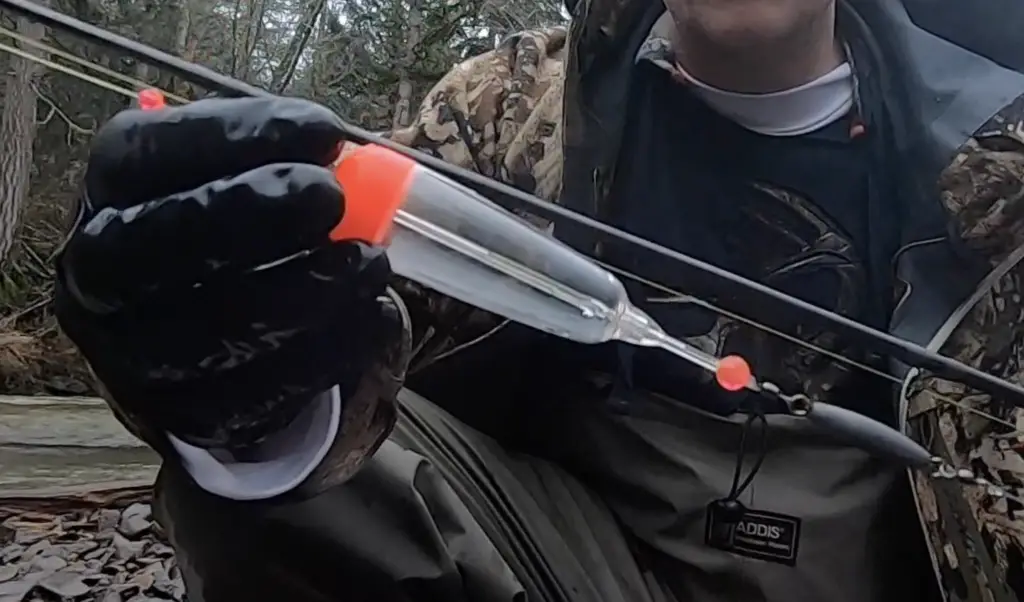
It used to be that drift fishing for winter steelhead was king of all angling techniques, and it’s still quite popular depending on where you fish.
However, float fishing for winter steelhead has dominated for a number of years now, and for good reason. As the float fishing technique does not require constant contact with the bottom, you lose far less gear.
Less time spent re-tying leaders means more time with your offering in front of winter steelhead.
Here are some convenient Amazon links for what you need to tie up a basic float-style setup. As an Amazon Affiliate, I earn from qualifying purchases through these links, but the price you pay is the same regardless, so please support my blog by using these links. Thanks!
- Bobber stop knots and stopper beads.
- Clear torpedo float 3/4 oz
- In-line sinkers 3/4 oz
- Beads to protect knot to bobber weight
Here’s what I used in the video for my terminal setup with soft beads:
- BnR Soft Beads SW WA Pro Pack
- 20 lb fluorocarbon leader line
- Gamakatsu Big River Bait Hook 1/0
- Split shot for leaders
The above links cover everything I used in the steelhead fishing video.
Most float fishing for winter steelhead is done using slip style bobbers so that the depth can be easily adjusted by a sliding dacron bobber knot on your mainline. If tying up a brand new float fishing setup:
- Start by slipping the bobber knot onto your mainline and pulling the black tube off your line towards you.
- Add a small bead (6mm) onto your mainline next, this will prevent your float from sliding beyond the bobber knot.
- Add your slip style float
- Add a larger bead (10-12mm) after the float
- Finally tie to an appropriately sized inline sinker matching the weight rating of the float.
On the other end of the inline sinker, you can tie a fluorocarbon leader (10-20 lb) to your offering.
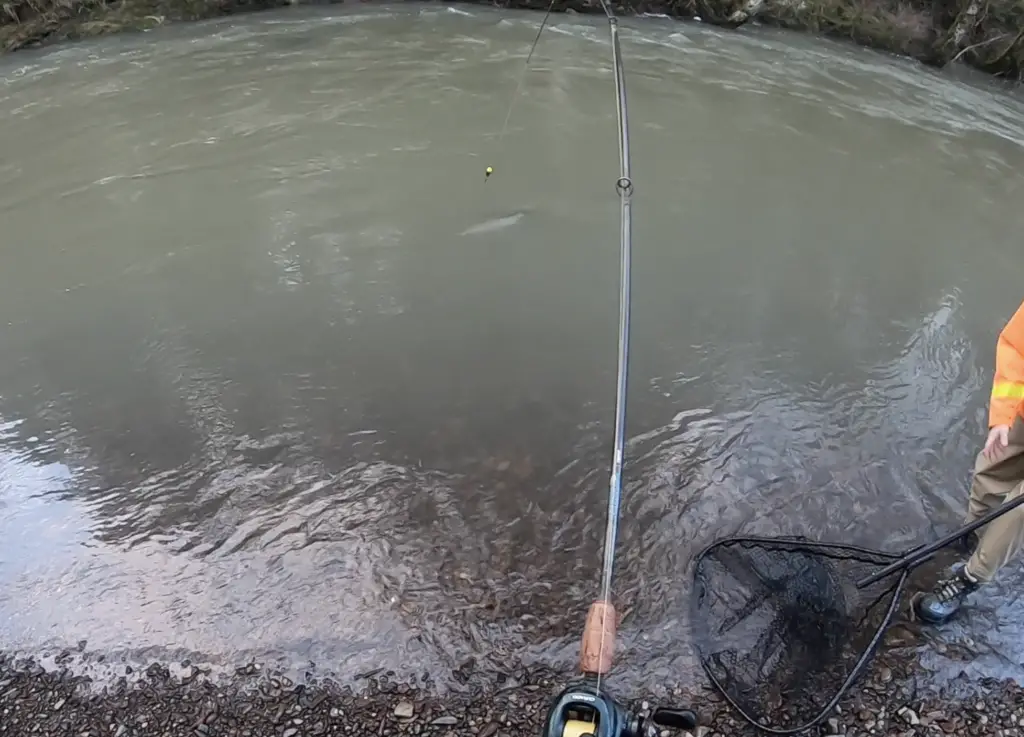
Popular float fishing terminal offerings are jigs, hooks tied with bait loop knots to hold roe, sand shrimp and other bait, rubber worms, and soft beads.
What size float and inline weight should you use when winter steelhead fishing?
The number one rule here is that the inline weight size should match your float. I like to use a 5/8th oz clear float and a 1/2 oz inline weight. I add a split shot on my leader or small 1/8th oz jig as my terminal offering and this adds up to about 5/8th oz of weight below my float.
In smaller, clearer water you are going to want to use smaller floats (and thus smaller weights).
In larger water where you may need to cast much further, a 1 or even 2-oz setup may be more appropriate. Match the float weight to the water you are fishing, and always match the inline weight and terminal offering to the float weight.
Why is this so critical to match float and inline weight?
This gets into the float fishing for winter steelhead technique itself. It’s important that your float stands straight up and down in the water when your terminal offering is not touching the bottom and river currents are fairly normal.
You can have differing river currents at different depths which pull your terminal offering or your float downstream faster causing your float to tilt forward or backward even when properly weighted and not touching the bottom.
I tend to upsize my float in these heavy current conditions to counter this.
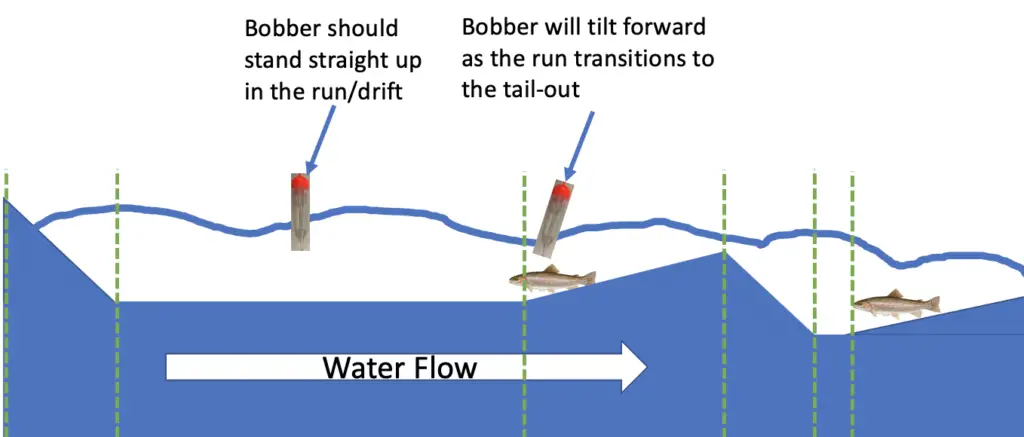
In “normal” conditions, you want your float to be straight up and down and only tilt forward if your terminal offering touches the bottom.
This visual aid is how you “find the bottom”. I always say “Find the bottom, find the fish”.
If you increase your depth by sliding your bobber stop knot higher on your mainline, eventually, your float will tilt forward as your terminal offering touches the bottom. You then slide your bobber stop knot towards your float 1-2 inches and you are now at the perfect depth for fishing for winter steelhead.
The above-described process is always the first thing I do in a new spot I’m fishing. If you don’t do this, how do you know you aren’t 4 ft above the bottom and completely wasting your time?
You can also use this technique to find the beginning of the tail-out per the above diagram. Remember that steelhead will often be holding in or just above a tail-out.
Float fishing rod and reel combinations
I highly recommend reading one of my other articles on the best fishing rod for salmon as much of it applies to steelhead as well. The rod and reel combo you will see in almost every float fishing video I’ve made for salmon and steelhead is what I’ve been using for the last 10 years with great success:
The 10’6 float rod is what I use to target steelhead with float fishing techniques reliably.
Why is this rod so helpful for float fishing for steelhead?
- The 10’6″ length means I can mend line quite easily in all the water I fish
- The fact that it’s a casting rod means I can release line and reel in my slack without the sometimes awkward challenge of closing the bail with a spinning rod setup.
- The action and stiffness balance allows me to get solid hook sets on any species of salmon or steelhead I’m fishing for while also having enough give that I rarely lose fish.
No 3 above is so important. That slower action and bend allow the rod to absorb the crazy runs, jumps, and turns of a feisty steelhead without popping the barbless hook out.

You can have short product description here. It can be added as and enable/disable toggle option from which user can have control on it.
The Shimano Curado. Load it with 30 lb high vis power pro. Seat it on your Okuma Guide Select Pro rod and you will be catching chrome like a pro.
Pair your float rod with the industry standard of casting reels, load it with 30 lb high vis braid and you are on your way to being a pro at float fishing for steelhead!
Float fishing for winter steelhead with jigs
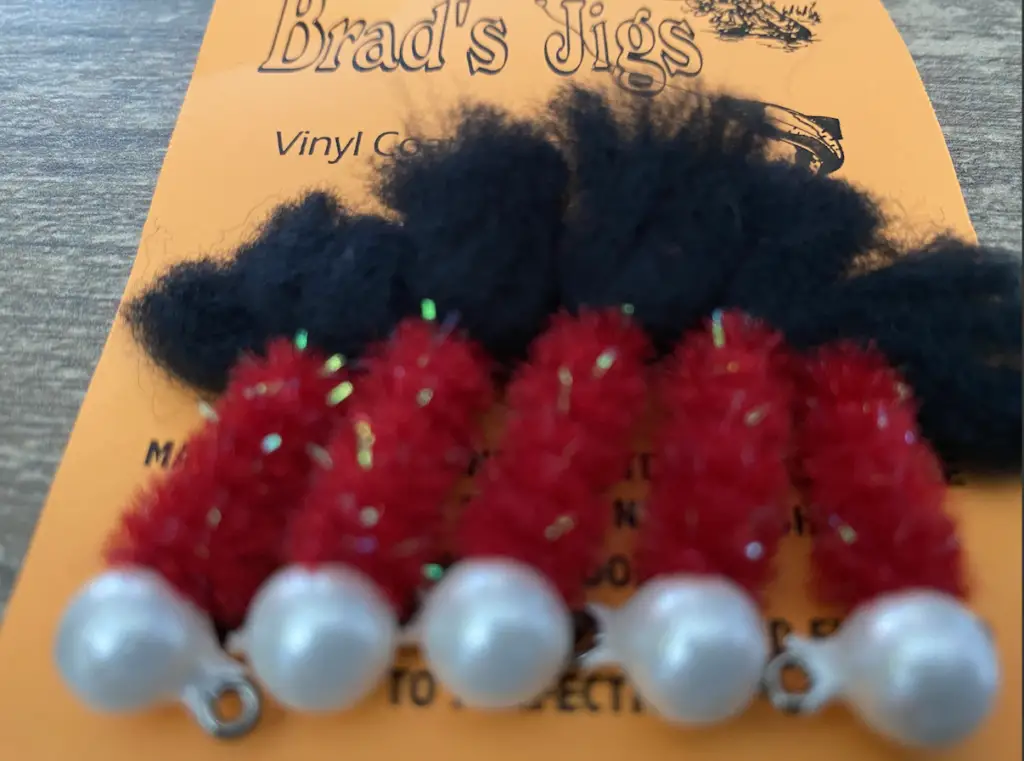
It’s hard to beat fishing for winter steelhead with jigs. I’ve caught so many winter steelhead on a nightmare pattern (black, white, red) 1/8th oz jig tipped with a little bit of store bought prawn…
Right now in many parts of Western WA (2021), we have a restriction against using bait. I tend to use jigs less if I cannot tip them with prawns.
I was on a sight fishing steelhead trip years ago that completely changed how I thought about fishing for steelhead.
The water was so clear we could see the steelhead holding in the current from our drift boat. The jigs tipped with prawns that were presented in front of the steelhead were bit 9 out of 10 times.
Without prawn? Far far less. I was also amazed at how easy it was to get them to bite if you put it right in front of them vs if you didn’t.
The confidence I felt after that trip has changed how I fish for steelhead. Put something they want in front of their faces and they will bite.
The trick is finding the part of the river where steelhead hold and then finding the bottom with your float fishing setup.
Float fishing for winter steelhead with eggs / roe
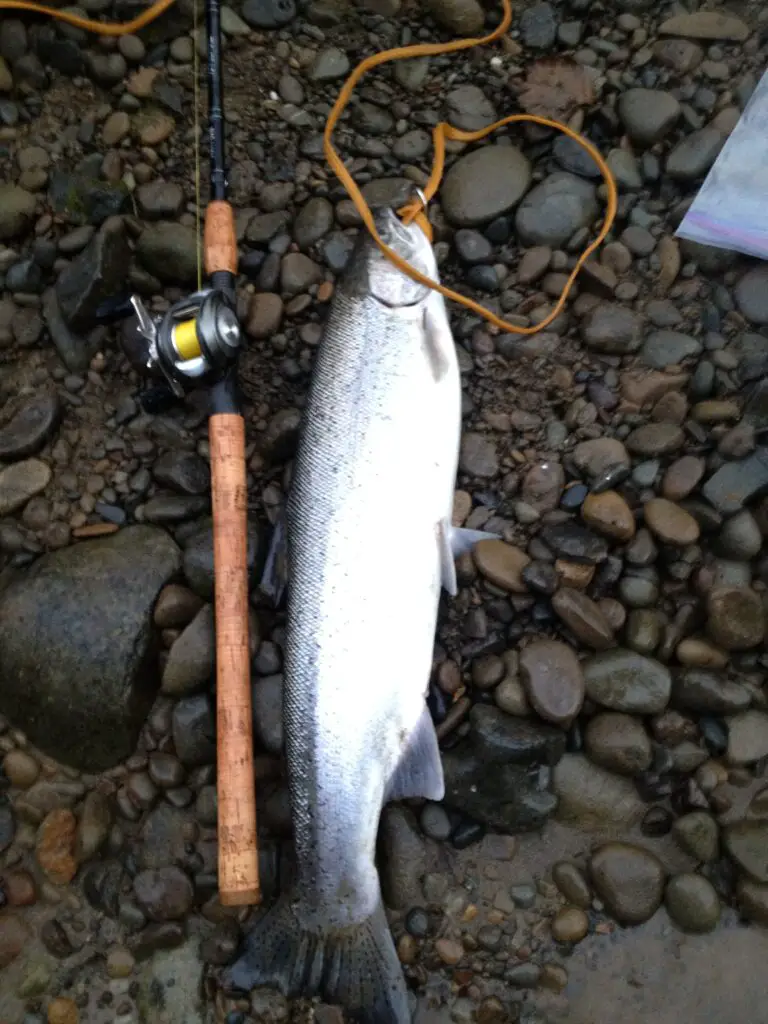
Using eggs for winter steelhead can be quite effective, but because I can get winter steelhead so readily with jigs/shrimp, I tend to not use my eggs for steelhead (I save them for king salmon).
Still, the right eggs can be absolutely deadly when presented correctly.
The above steelhead flashed its chrome side such that I could see it in the drift as it rapidly turned around and hammered my eggs that had floated past its position a second earlier.
Float fishing for winter steelhead with soft beads
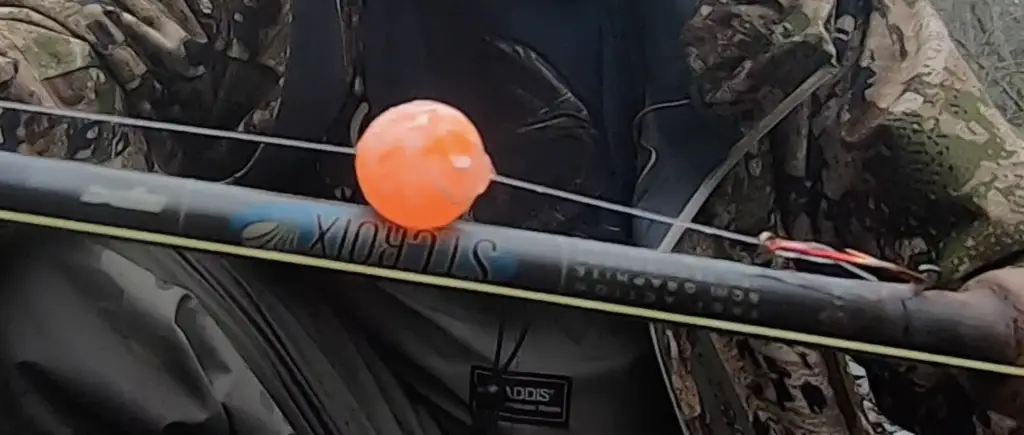
Using soft beads under a float is probably my #2 behind jigs tipped with shrimp.
There are several brands of soft beads on the market, but I’ve only used the BnR Tackle soft beads as they work really well, and they come in many sizes and colors.
The Amazon link above will get you started with their pro pack.
Bobber dogging for Winter Steelhead

Bobber dogging is a newer (ish) technique that combines the constant bottom contact of drift fishing with the visual indicator of the bobber for a potential bite.
Additionally, bobber dogging can fish certain types of water that other methods simply cannot reach effectively.
Drift presentations tend to swing through the current towards you (and sometimes out of the water you are trying to fish) and float presentations can move too quickly through the water due to not having contact with the bottom.
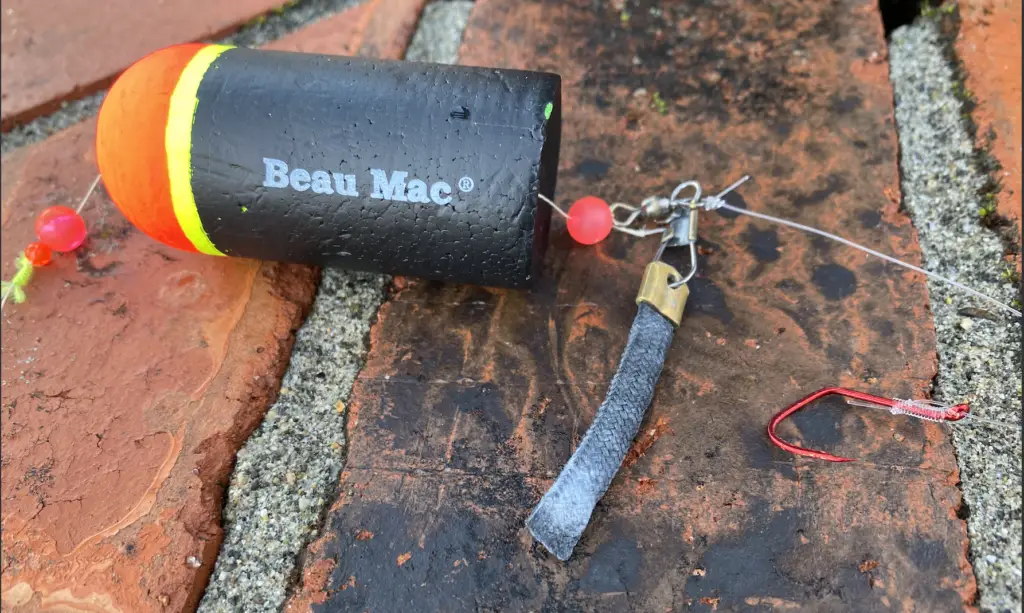
Here’s how you rig up for bobber dogging for steelhead:
- Start by slipping the bobber knot onto your mainline and pulling the black tube off towards you.
- Add a 6mm bead onto your mainline next, this will prevent your float from sliding beyond the bobber knot.
- Add your slip-style float, ideally one that is designed for bobber dogging (more compact for casting, wider hole to thread your main line through).
- Add a 10mm bead after the float.
- Finally, tie to a swivel that an appropriately sized drift sinker can be attached to.
The appropriate size of the drift sinker for bobber dogging is different than for float fishing, this is because with bobber dogging you will always want your weight to be in contact with the bottom and thus the float to be pointed downstream but not being pulled under.
If you were to add a 1/2 oz weight to a 1/2 oz float it would be pulled under too often.
You generally want a weight that is around 50%+ of the float’s rating.
So a 1/2 oz float gets a 1/4 oz drift weight (such as a slinky weight). I will also go 3/8 oz weight for a 1/2 oz float, it just depends on the water I’m fishing and how grabby the bottom is.
A mud or pea gravel bottom could get away with 3/8 oz weight, but a rockier bottom may need 1/4 oz.
My favorite way to manage a float presentation is with a casting reel because of how easy it is to mend line.
However, because the lighter weights often used with bobber dogging combined with the resistance through the air caused by the float, I like to use a spinning setup for bobber dogging for winter steelhead.
One other aspect is that when you are casting out, you want to place your finger on the spool just before everything hits the water to prevent the potential tangle that can occur with bobber dogging casts.
This stops the line coming off the reel midair and causes the entire presentation to straighten out before it hits the water to avoid a tangle.
You will want to set your bobber stop to be the depth of the river + 1-2 ft (or more). This is so your drift weight will always have contact with the bottom.
Depending on water clarity, your leader can be anywhere from 2-4 ft in length. You can fish a variety of terminal presentations such as soft beads, corkies, yarnies, eggs, etc. Basically, use the same type of presentations we will cover in the next section on drift fishing for winter steelhead.
I generally use bobber dogging in a few situations:
- Water that is faster than what is ideal for a float fishing presentation, slightly faster than walking speed water. High water conditions may present these conditions.
- Water with an uneven bottom structure. Such as a drift that may shallow out dramatically before deepening again.
- Water that is so turbid (low visibility), that I want to present my offering quite slowly.
One other thing to note here, there is often a lag of several seconds between when a fish picks up your offering and when you see your float go down.
There’s also oftentimes a lot of slack line in the water. As soon as the float goes down, you need to reel like crazy until you feel the steelhead (sometimes it’s just a grabby bottom) and only then do you set the hook.
You should also use the shortest leader you can get away with here as the longer the leader, the longer the delay between a steelhead picking up your offering and your float going under.
A leader length of 2-3 ft is usually the most appropriate.
Bobber Dogging rod and reel combinations
While you can make a casting setup work, and you can go with a longer rod like a 10’6″, I actually much prefer a smaller spinning setup. Often times I’m bobber dogging during high water, I may not have as much room on the bank to cast and I don’t need to mend line as aggressively compared to float fishing.

The above rod will not set you back much and has a nice balance of action and power to get a good hook set with enough give and sensitivity to hold fish.

You can have short product description here. It can be added as and enable/disable toggle option from which user can have control on it.
These reels perform well and last a long time. They hold plenty of braided or mono fishing line and provide good drag to help fight those big winter steelhead.
Pair the spinning rod with one of these nifty Daiwa spinning reels and you have another winning combination.
Drift fishing for Winter Steelhead

Much has been written on how to drift fish for winter steelhead, so I will try to summarize and provide my spin on it. I highly recommend the book on the topic by Bill Herzog for a full exploration of the topic.
Most conventional knowledge of drift fishing involves tying your mainline to a swivel / drift sinker of some sort like a slinky weight and then tying a 2-5 ft leader to that same swivel which is holding the drift weight.
One of the techniques I read about in Herzog’s book is a different way to drift fish and one that I actually prefer, especially for winter steelhead fishing.
This technique involves rigging up for a sliding drift sinker vs a fixed weight system:
- Run your mainline through the snap swivel which is holding the slinky weight
- Run a 8-10mm bead on your mainline after the snap swivel.
- Tie your mainline to another swivel (I use a small barrel swivel here)
- Tie your same 2-5 ft leader to the other side of that swivel.
In a fixed-weight system, you usually try to use a lighter weight that will only touch the bottom every several seconds as it is drifting along. You cast upstream slightly such that it first touches the bottom around your position and you let it continue to swing downstream and towards you at a generally fast clip.
Many times drift fishing with a fixed weight is a favored technique as you can fish many types of water, and there’s an added bonus that you have a chance to floss a steelhead or have them bite it. You can read my page titled Flossing for salmon for more depth on this controversial topic.
For the reasons I explain on that page, flossing is not something I generally do, and I also tend to avoid techniques that lead to inadvertent flossing.
You can fish a sliding weight system identical to a fixed weight system though it loses some sensitivity with regards to feeling what’s going on when you fish it the same as the fixed weight.
The drift fishing technique with a sliding weight system I’m going to discuss however is a bit different.
You use a slightly heavier weight. So if a fixed weight situation calls for 3/8 oz, you might end up using a 1/2 oz weight.
You do not cast upstream at all, in fact, you cast slightly downstream. You should have enough weight for your setup to settle at the bottom without moving much downstream or toward you.
Your weight and leader should slowly and gently swing towards you. You want to keep the slack out of your mainline or your offering could get pulled downstream and out of position, so mending is important.
You may need to gently lift your rod tip to help your drift weight swing towards the shoreline you are standing on ever so gradually. This lifting of the rod tip will sometimes detect a bite as well.
The sliding weight system allows you to get away with a heavier weight and still be able to fill a bite quite readily because there’s no weight between you and the fish as the sinker can slide freely.
This technique is less like traditional drift fishing and more like a combination of back bouncing and swinging a spoon/spinner / fly. The point of using this technique is to present your offering right in the steelhead’s face and slowly, giving them plenty of time to decide to bite.
Too many steelhead anglers are obsessed with “natural presentations”.
I was on the river the other day with someone who was in love with their center-pin setup for float fishing. And don’t get me wrong, center-pins are awesome for float fishing, and require significant skill and dedication to master.
However, the only steelhead caught that day came from the dude fishing the bobber dogging setup with a huge soft bead.
Why? Because his offering was moving quite unnaturally slow and it was large enough so the steelhead could make up its mind to bite. The river was high and off-color that day which gave the advantage to bobber dogging or a drift fishing setup like what I’m describing above.
Matching your technique to the conditions of the river that day is critical for success with winter steelhead fishing.
Don’t romanticize your fishing technique just because you saw the movie “A river runs through it”. Use what works for the conditions!
Rod and reel combination for drift fishing
I like to use a super fast action tip rod for drift fishing and I want to have the most feel possible while also balancing good bend with hook set power.
I’ve always liked using Lamiglas rods for drift fishing. I don’t have a link to it, but if you want to spend more on a drift fishing rod, the Stealth SI or XMG50 series were great drift fishing rods as well.
Pair my standard Daiwa spinning reel with the X11 spinning rod and you have another winner.
Using Spinners and Spoons for Winter Steelhead
I would read my page on spinner fishing for salmon as a great primer to get started throwing spinners for winter steelhead.
The main caveat is that you are using the heavy bodied technique typically and being near the bottom, especially in particularly cold rivers is going to be important to getting bit.
My Favorite Books on how to Fish for Winter Steelhead
This book will teach you the most important methods of drift fishing for steelhead by the well-known author Bill Herzog. I’ve used the drift fishing techniques described here extensively for steelhead and salmon and they work!
This book on spinner fishing for steelhead and salmon is not the Jed Davis spinner fishing bible, but it’s a solid reference for learning about spinner fishing for steelhead.
Determining Where to Fish for Winter Steelhead and When to go
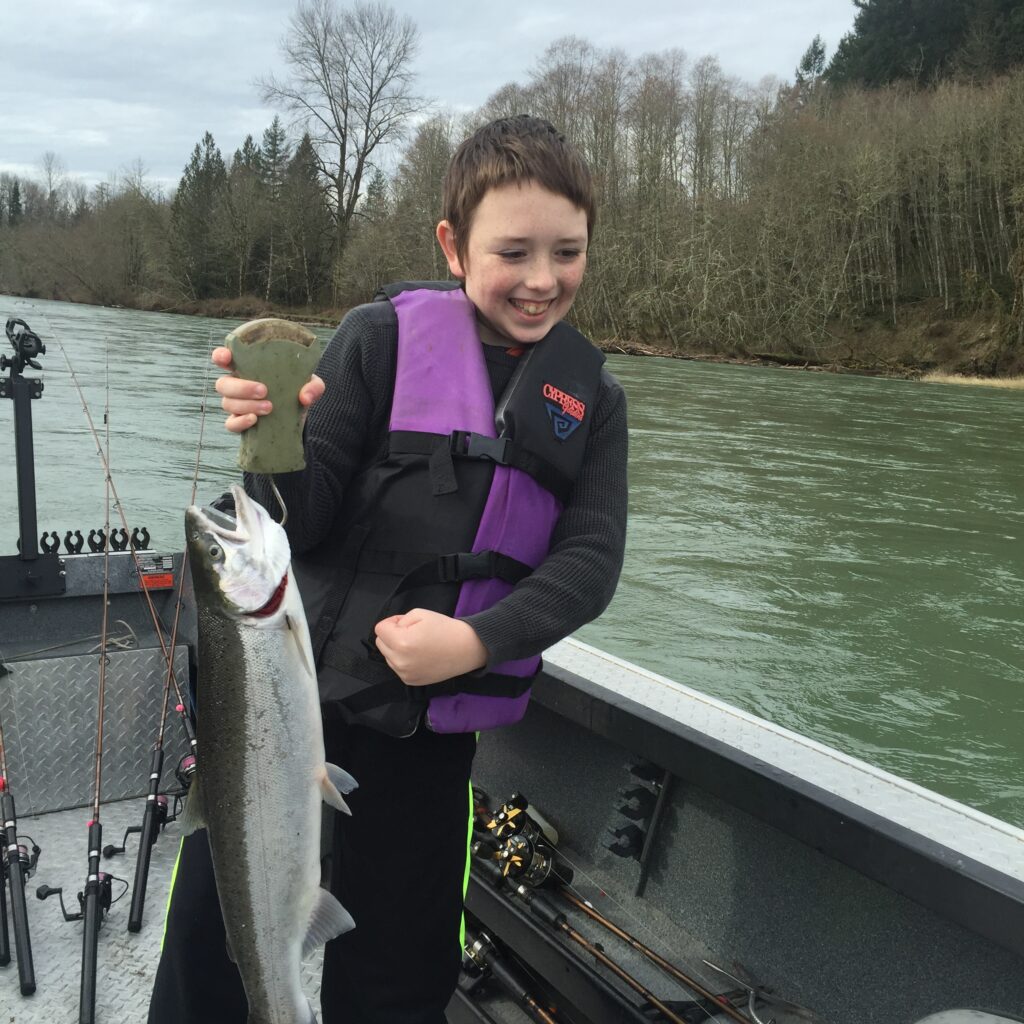
At this point, you should have some idea of where to look in the river for winter steelhead. You should also have some ideas about how to rig up, and how to fish for winter steelhead based on the appropriate method for the water conditions.
But how do you determine Where and When to go fishing for Winter Steelhead?
For starters, I’m not going to draw anybody a map to anybody else’s favorite winter steelhead fishing spot. I may mention a river on the blog that most people already know, but there are several rivers I won’t mention. I will provide you the tools, however, if you put the work in, to figure it out for yourself.
Even if you know where to go, you need to pick the right day. If you only have one day to go, you may want to pick an appropriate river based on the water conditions as well as whether you expect winter steelhead to be present.
Fishing Regulations
You should always look at the regulations before you go winter steelhead fishing as they can change year to year or after the season starts (like an emergency closure) and you need to be aware or you could risk getting a ticket.
You can also look at the fishing regulations for a clue as to which rivers have steelhead runs on them. If they allow steelhead retention specifically, well there’s a good clue.
Some will have general trout rules which also apply to steelhead, or specify catch and release and no retention. These rivers/creeks may have wild runs that are healthy enough to fish, but not retain.
Hatchery escapement reports
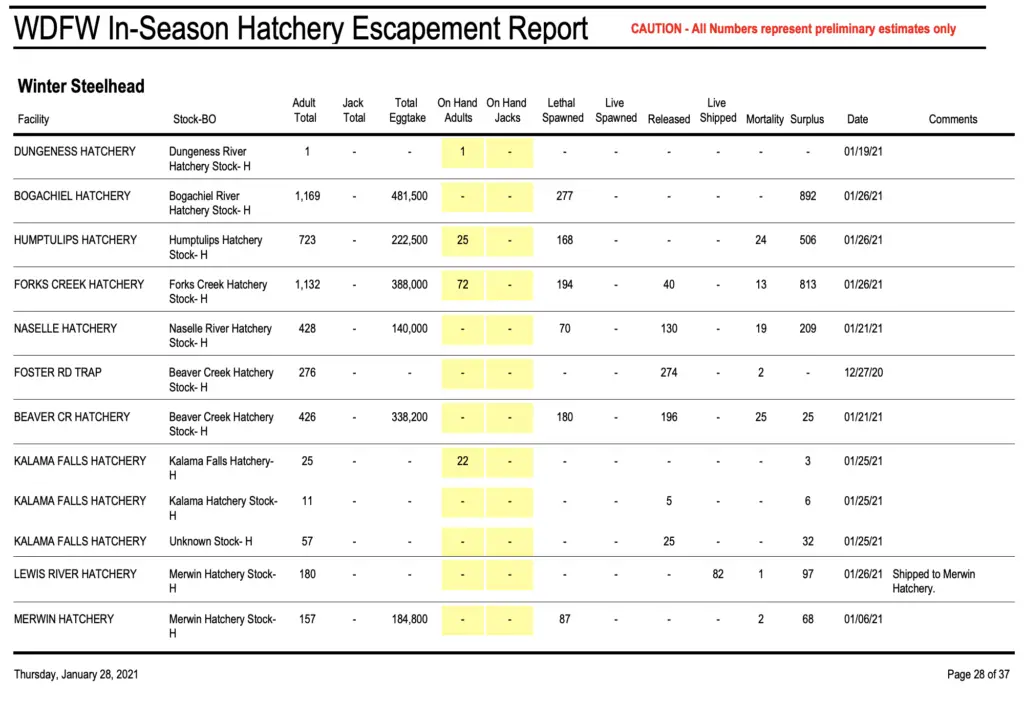
In the WDFW Hatchery Escapement Reports, there’s a section just for Winter Steelhead and Late Winter Steelhead. So you can see which rivers have hatchery steelhead.
You should also look at the reports from last year…Sometimes a hatchery won’t be listed until they report their first steelhead that’s returned to the hatchery…and they don’t always report that on time.
Local hatchery personnel tend to fish these same rivers and won’t necessarily be urgent about publishing their escapement right when it happens…if you catch my drift.
If you look at last years reports and you see the first report in February, you may want to try that river in January as well. You might be surprised.
Water flow data
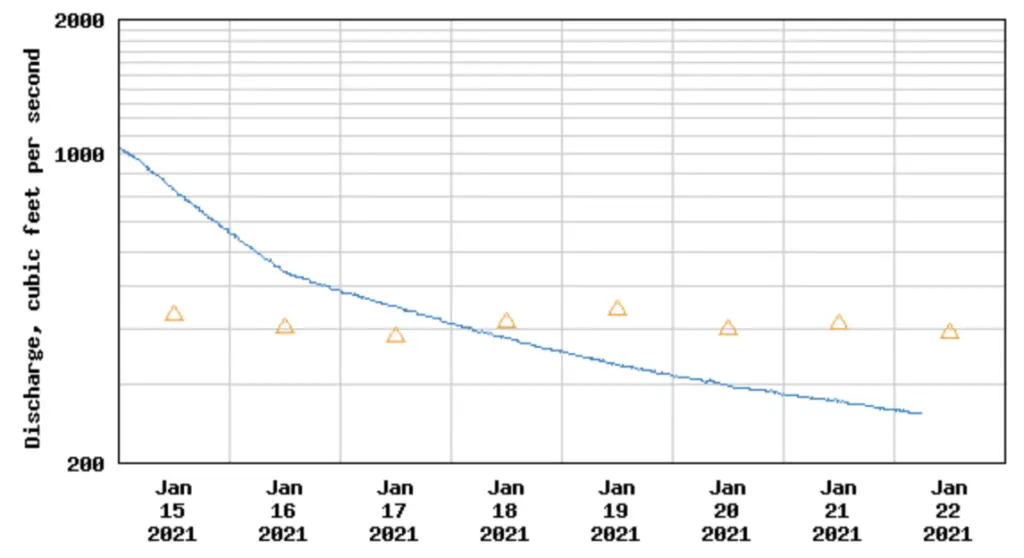
Water flow data available on USGS is super important for understanding when to go. It’s no good and can even be dangerous to fish for steelhead in a river that is on a dramatic rise or is chocolate milk with trees going down the river.
You want to fish most rivers on the drop. Don’t wait for it to be perfect though. Everybody wants to hit the river when it gets to “Steelhead Green”, fish it before that and afterward and you will still find plenty of fish.
If a river has been at low flow for some time since a high water event, there will often be fewer fish in that system, especially if it’s early on in the run. The winter steelhead will just wait in the salt for the next surge of freshwater before moving up.
Later in the season, the steelhead may be more urgent and come into the river in good numbers even at lower flows.
Stocking reports
Most of the time, the rivers that had hatchery steelhead smolts planted in can also be found on your local DFW’s website. This can give you a clue in terms of where to go and what to expect in terms of numbers.
Just go!
Don’t be that guy or gal that just waits for an internet forum or publication to talk about the winter steelhead fishing being good on a particular river.
Half of the fun and adventure is just going. Go explore. It’s okay if you come back empty-handed. If you just want to put meat in the freezer, you will save money by driving to Costco and buying farmed steelhead fillets there instead.
Henry David Thoreau wisely noted that “Many men go fishing all of their lives without knowing that it is not fish they are after.”
Learn as you go. Keep a fishing journal of the river / weather conditions, note your thinking prior to the trip and then record your actual experience and success or lack thereof. I now have hundreds of journal entries that are my single best source of intel before I go fishing.
The Best Gear for Winter Steelhead Fishing
Waders and staying warm while Winter Steelhead Fishing
There are generally two approaches to waders for winter steelhead fishing.
You can go with the classic neoprene waders which are super warm and help stave off the chill of standing in 38 degree water waiting for a steelhead to bite.
Or you can go with a breathable lighter material wader, and add layers of thermal protection underneath the waders
I prefer the breathable approach as I fish all year long and I like to use the same waders for summer and winter. If you primarily fish in the winter time though for winter steelhead, the neoprene may be more ideal. They are also generally cheaper.
If you go the breathable waders route, you better come prepared to be warm. Wool socks, thermal base layers, and the like.
Also, if you get the stocking foot waders (usually nicer and more comfy with a good wading boot), you should really get the neoprene wading socks. Most leaks will happen in the stocking foot, and your 200$ + pair of waders may only last a season as a result. I finally started using the neoprene socks and I stopped having leaks. I’ve bought every brand of waders from 70$-400$, and all of them will eventually get a leak without the neoprene socks.
The gloves you need for Winter Steelhead Fishing
You cannot get around the fact that you will be fishing for winter steelhead in the cold. Some people are impervious to cold. I’ve seen dudes out there in 30-degree weather in a t-shirt. I’ve seen plenty of people fish without gloves.
Not me! If my hands get cold enough they stop working. Good luck tying a fishing knot or opening a snap swivel when your fingers stop obeying orders!
Not all gloves are created equal though.
The beauty of wool gloves is that they can get wet and still hold warmth. This is not true with other material types. And your gloves will get wet. It’s important to use fingerless gloves. Yes, your fingertips may be burning with cold, but as long as your hands are warm you will still have dexterity. It’s really hard to fish for winter steelhead when you have your fingers in gloves.
The best gloves for winter steelhead fishing are these buffalo wool gloves. I’m on my second pair of them over the past 11 years. They cost more than traditional wool, but they are worth every cent.
Tackle bag and other gear you may need / want
If you are going out there with a traditional backpack or tackle box, you will soon find that you need something better. There’s no escaping that everything you bring out is going to get really wet. So it needs to be waterproof. You will also find yourself hiking to a fishing spot or two at times to go where the winter steelhead are.
The solution? The waterproof backpack. I organize my tackle in ziplock bags for leader rolls or these plano boxes that I can toss into my waterproof backpack and just go. Everything stays dry and well organized.
How many times do you get to the river before fishing light to make sure you can get into your preferred fishing spot? What do you do while you wait for the sun to come up? One of my favorites and also for many others is to make a fresh hot beverage or even freeze-dried breakfast right there on the gravel bar with this nifty rapid water boiling system.
I use it for fishing from the bank, for hunting and for trips on the boat. It’s awesome!
Combined with the best instant coffee on the planet, you’ve got a solid distraction to warm you up while you wait for sunrise.